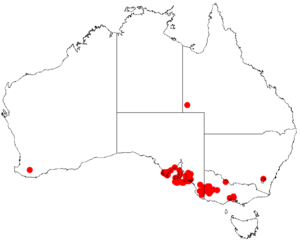Daintree wattle facts for kids
Quick facts for kids Daintree wattle |
|
|---|---|
| Scientific classification | |
| Genus: |
Acacia
|
| Species: |
cincinnata
|
 |
|
| Where the Daintree Wattle grows in Australia (data from AVH) | |
Acacia cincinnata, also known as the Daintree wattle or circle fruit salwood, is a special type of tree. It belongs to the Fabaceae plant family, which includes many legumes. You can find this tree growing naturally in the northeastern part of Australia.
What it Looks Like
The Daintree wattle is usually a small tree. It can grow from 5 to 25 m (16 to 82 ft) (about 16 to 82 feet) tall. Some have been measured with a trunk thickness of 60 cm (24 in) (about 2 feet) across.
Its bark is dark grey to black. It often looks furrowed, meaning it has grooves, and flaky. The tree's branches are strong and have a slightly angular shape. They are also lightly hairy and a pale brownish-grey color.
Like many Acacia trees, the Daintree wattle has phyllodes instead of true leaves. Phyllodes are flattened leaf stalks that act like leaves. These phyllodes are evergreen, meaning they stay green all year. They are shaped like a narrow oval, tapering to a point at both ends. They are 10 to 16 cm (3.9 to 6.3 in) (about 4 to 6 inches) long and 11 to 30 mm (0.43 to 1.18 in) (about 0.4 to 1.2 inches) wide. Each phyllode has three clear main veins.
The tree blooms between May and June. During this time, it produces bright yellow flowers. These flowers grow in clusters called inflorescences.
How it was Named
A botanist named Ferdinand von Mueller first officially described this tree in 1878. A botanist is a scientist who studies plants. He included the description in his work called Fragmenta Phytographiae Australiae.
Later, in 1987, another botanist named Leslie Pedley reclassified it. He moved it to a different group called Racosperma cincinnatum. However, in 2006, it was moved back to the Acacia group. So, its scientific name is once again Acacia cincinnata.
Where it Grows
The Daintree wattle is endemic to Queensland, Australia. This means it only grows naturally in this specific area.
You can often find it at the edges of rainforests. It prefers damper places in areas like the Atherton Tableland and the Eungella Range. It also grows along the coast nearby. In high rainfall areas, it can be found between Maryborough and Brisbane.
This tree also likes to grow along river banks. It can be seen in open Eucalyptus forests. It usually grows in sandy soils, especially those found over granite rock.

